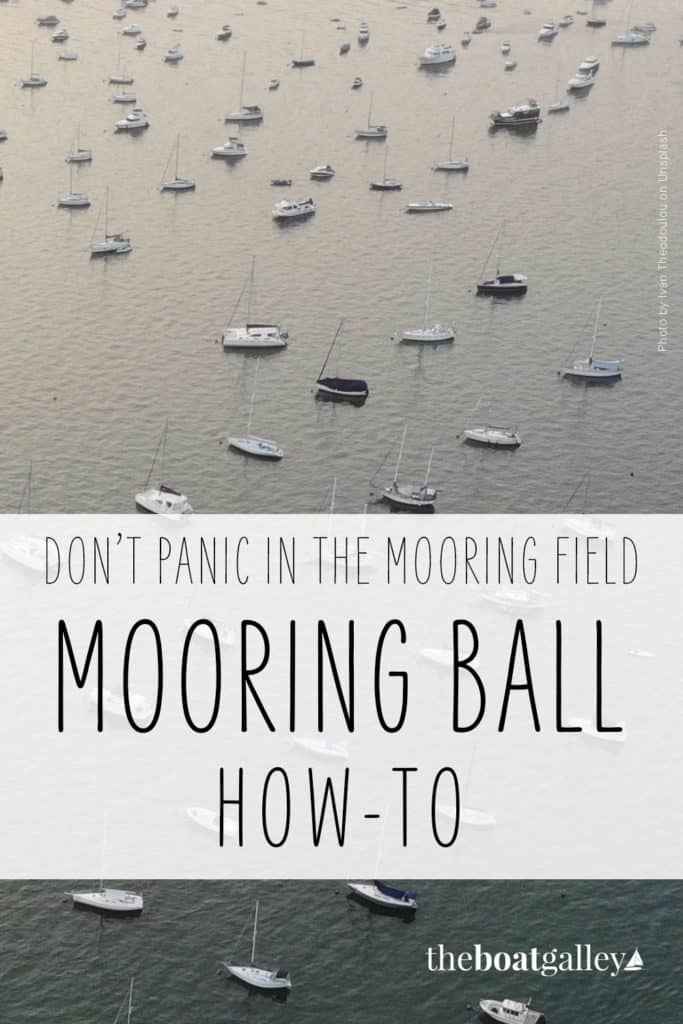
Most mooring balls have a pennant with an eye that you tie up to. And here in Boot Key Harbor (Marathon, FL) the marina staff is emphatic about teaching the right way to tie up to one!
What seems to be the obvious way to tie up is to secure one of your dock lines to the forward cleat on one side of the boat, pass the line through the eye, and then cleat it to the forward cleat on the other side of the boat. And that is wrong.
The problem with doing it that way is that as the boat swings and moves in the wind and current, the dock line will quickly chafe on the eye . . . and pretty soon – at night when it’s blowing, of course – it’ll break. That’s actually worse than having an anchor drag – if your anchor drags, it slows your motion. If the line breaks, the boat moves downwind much faster.
How to Tie Your Boat to a Mooring Ball
The “much-less-chafe” way to tie up is to pass a line from each forward cleat through the eye and then back to the cleat it came from. This way, neither line saws back and forth on the eye.
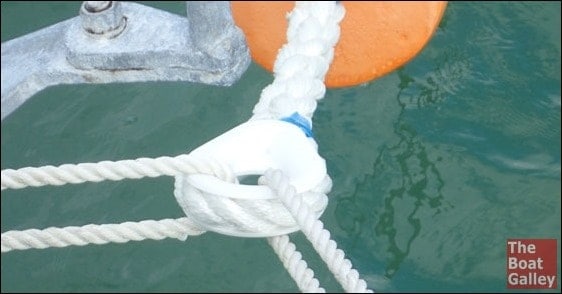
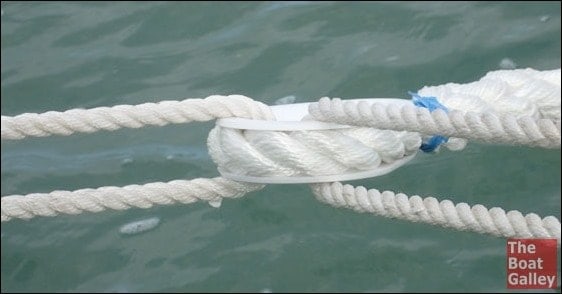
Here at BKH, marina staff make a point of telling you this as you check in and the pump out boat staff also checks boats as they go through the anchorage. They’re not being nasty or just sticklers for following the rules, they’re making sure that no boats go “floatabout” or go through the anchorage bouncing off others.
Even if you don’t totally chafe through with one line going from side to side, it puts a lot more wear on your (expensive) dock lines. Using two lines is safer and less costly in the long run.
The other mooring fields that we’ve been at – whether on our boat or on charter – haven’t said much about the proper way to tie up. The charter companies in the BVIs didn’t tell us a thing. Last year, I was talking to one of the office staff here at BKH and she said that since they’d been making a point to tell people to use two lines – and why it’s better – they’ve had almost no boats break free.
TIP: When you first tie up to a mooring, don’t worry about getting both lines in place. Just do one. Then when it’s secure, you can do the other. Finally, adjust the length of both so they’re even (in BKH, they request that there is no more than four feet from your bow to the eye. This way, all boats swing in roughly the same way).
The Best Line to Use For Tying to a Mooring Ball
Three-strand nylon line is best for tying up to a mooring line as it provides a bit of stretch and hence shock absorption when gusts or waves hit the boat. My favorite is made by New England Ropes, as it is manufactured to have superior chafe resistance. You can buy it either as straight line or with an eye pre-spliced in one end. Read more about the best line.
Tying Up to a Mooring Ball for a Storm
To tie up to a mooring ball for a squall or tropical system, use three-strand lines with spliced eyes in one end (making a loop by tying a knot weakens the line far more than using a line with a spliced eye). Pass the eye through the pennant, then the free end of the line through the eye. Do this for both port and starboard and if there is sufficient room on the pennant, add a safety line that goes to a different attachment point on the boat.
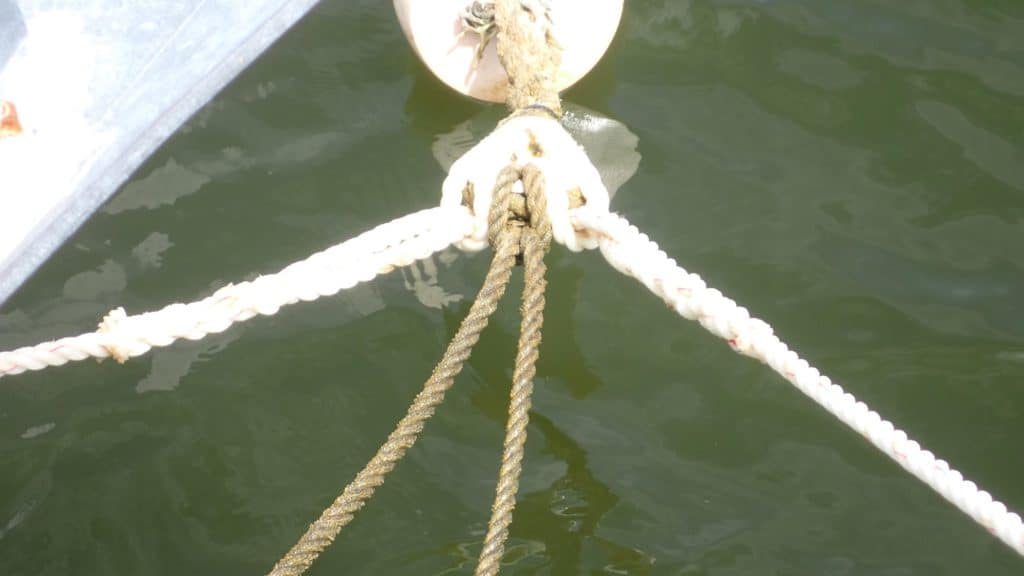
Most mooring fields prohibit you from using an anchor in addition to the mooring or using any metal — shackles or chain — to attach to the mooring system as these will foul and chafe the mooring.
Before planning to use a mooring ball for a storm, check with the owner as to the inspection and maintenance schedule as well as the design. Helix mooring anchors that are inspected and repaired if necessary every four months or less are considered the gold standard.
Chafe Gear
Avoiding chafe at the pennant is only one part of the equation. You also need to protect your lines from chafe at the boat. The best chafe gear is fire hose, which you can get for free at most fire stations (they may give it to local marinas or the Coast Guard auxiliary, too). Rather than tying it to the line — which can stretch and the chafe gear end up in the wrong place — we tie it to the boat or cleat and then it stays where it is needed, regardless of how much the line stretches.
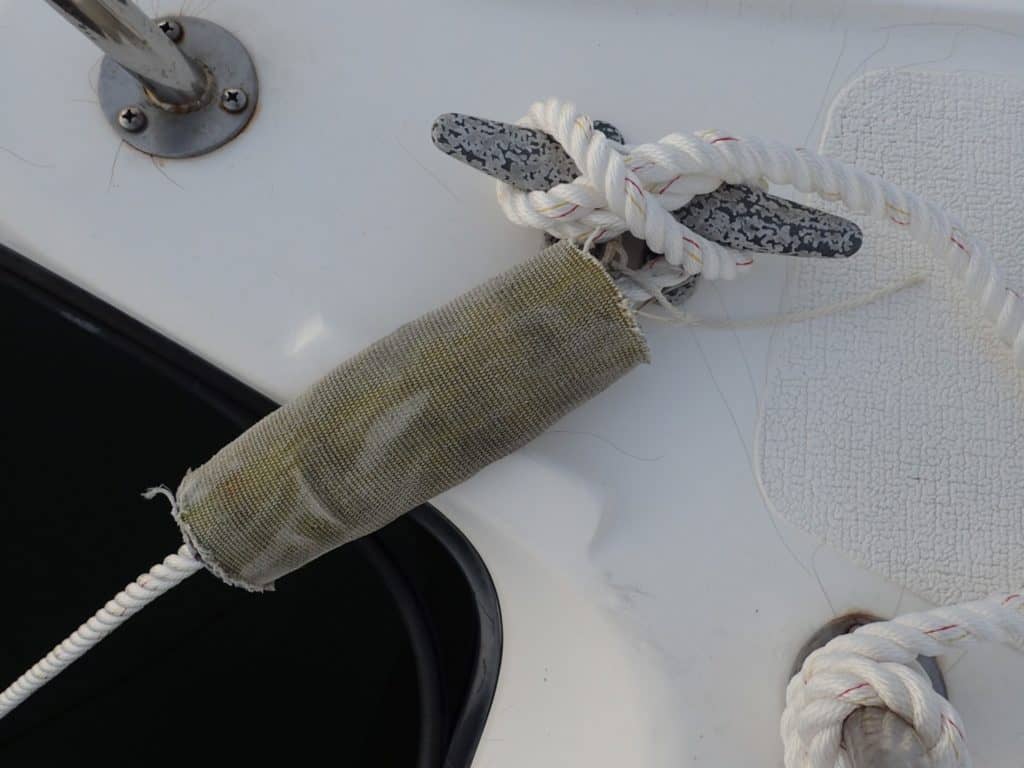
This article was originally written in December 2015 and was substantially updated and enlarged in February 2020.
Read Next

Quickly find anchorages, services, bridges, and more with our topic-focused, easy-to-use waterproof guides. Covering the ICW, Bahamas, Florida, and Chesapeake.
Explore All Guides

Carolyn Shearlock has lived aboard full-time for 17 years, splitting her time between a Tayana 37 monohull and a Gemini 105 catamaran. She’s cruised over 14,000 miles, from Pacific Mexico and Central America to Florida and the Bahamas, gaining firsthand experience with the joys and challenges of life on the water.
Through The Boat Galley, Carolyn has helped thousands of people explore, prepare for, and enjoy life afloat. She shares her expertise as an instructor at Cruisers University, in leading boating publications, and through her bestselling book, The Boat Galley Cookbook. She is passionate about helping others embark on their liveaboard journey—making life on the water simpler, safer, and more enjoyable.
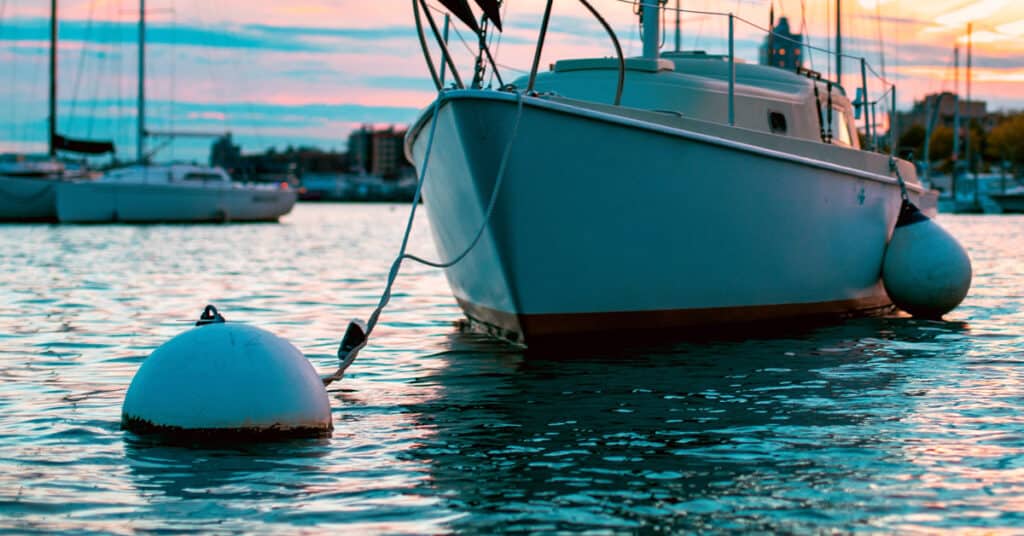


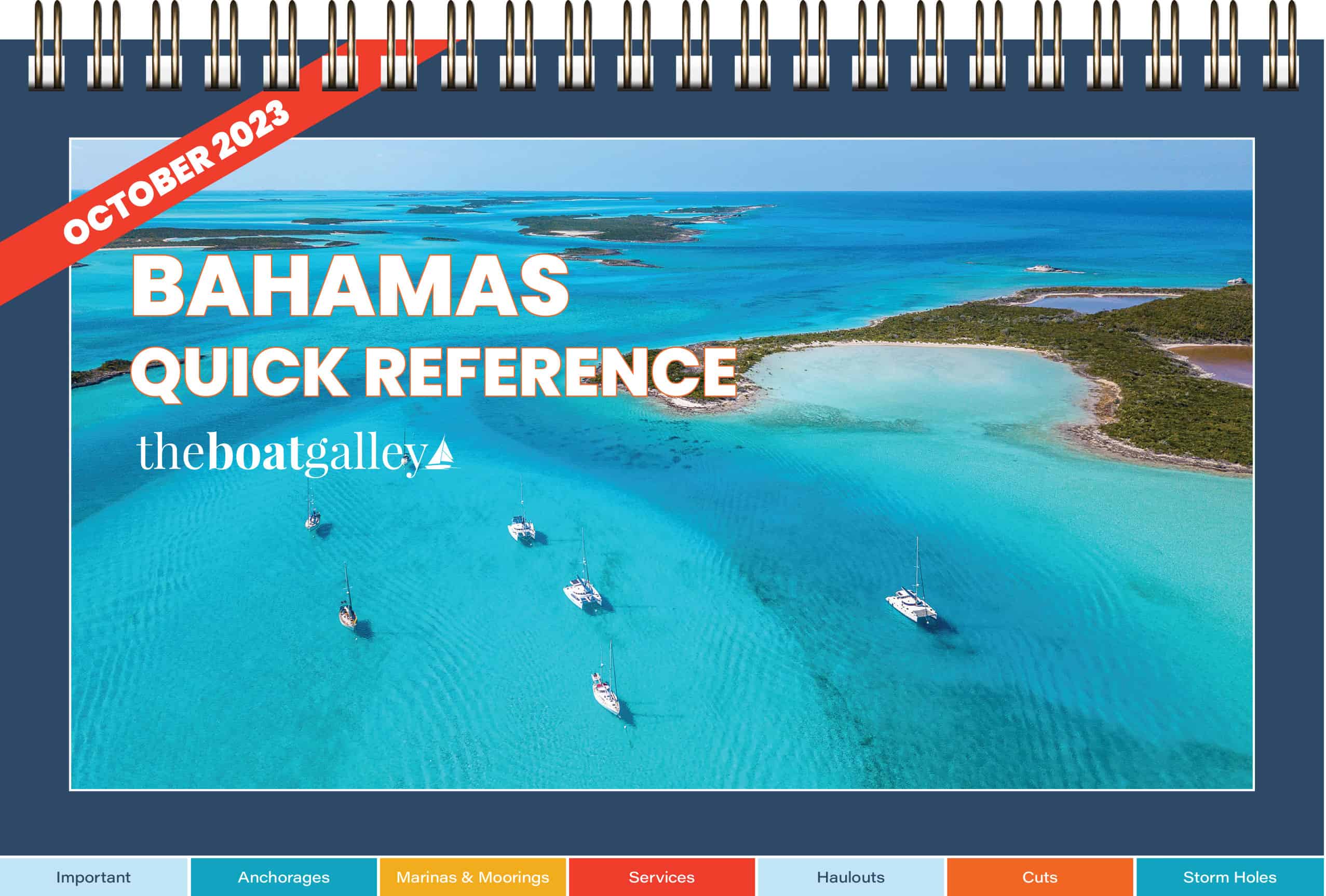
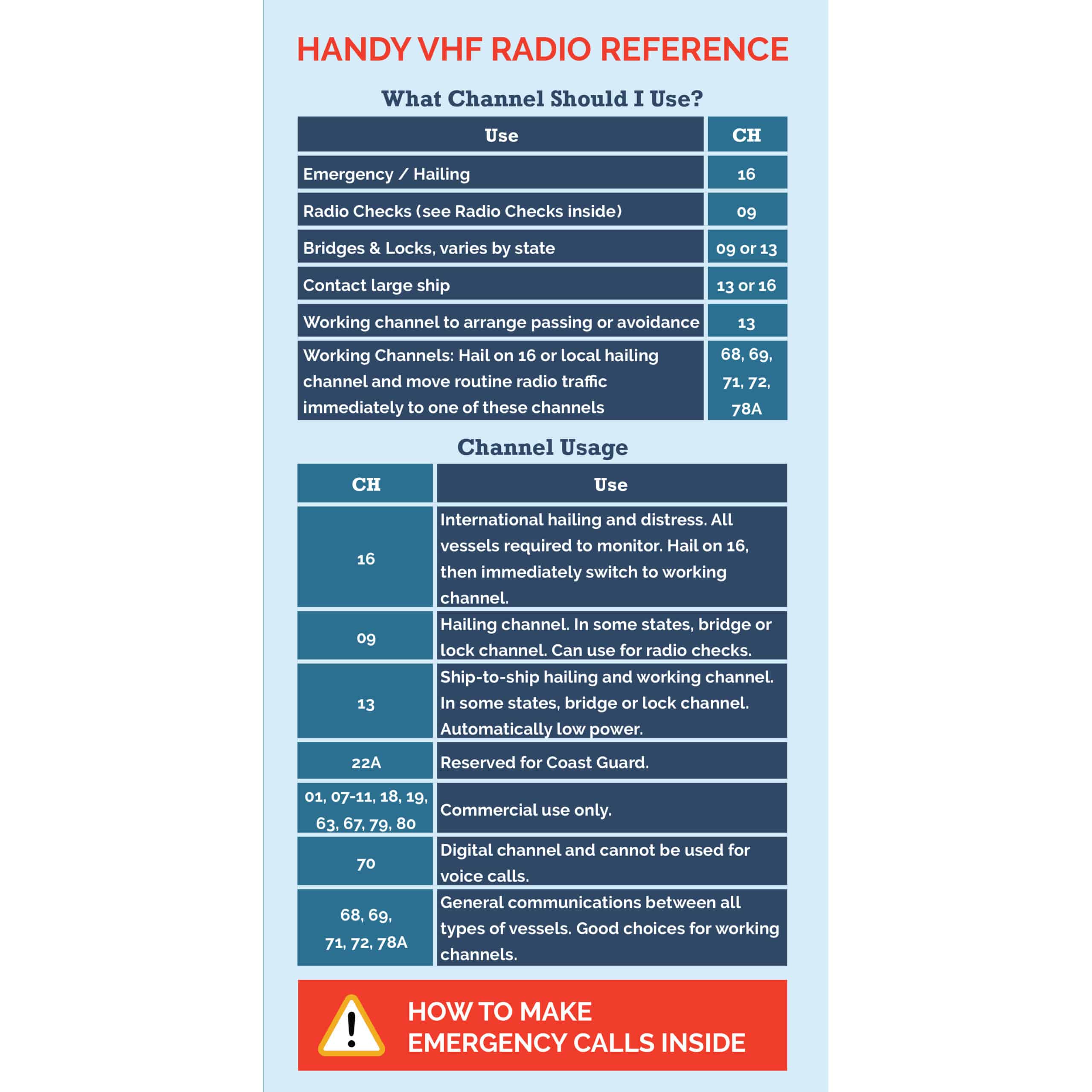




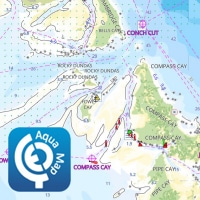
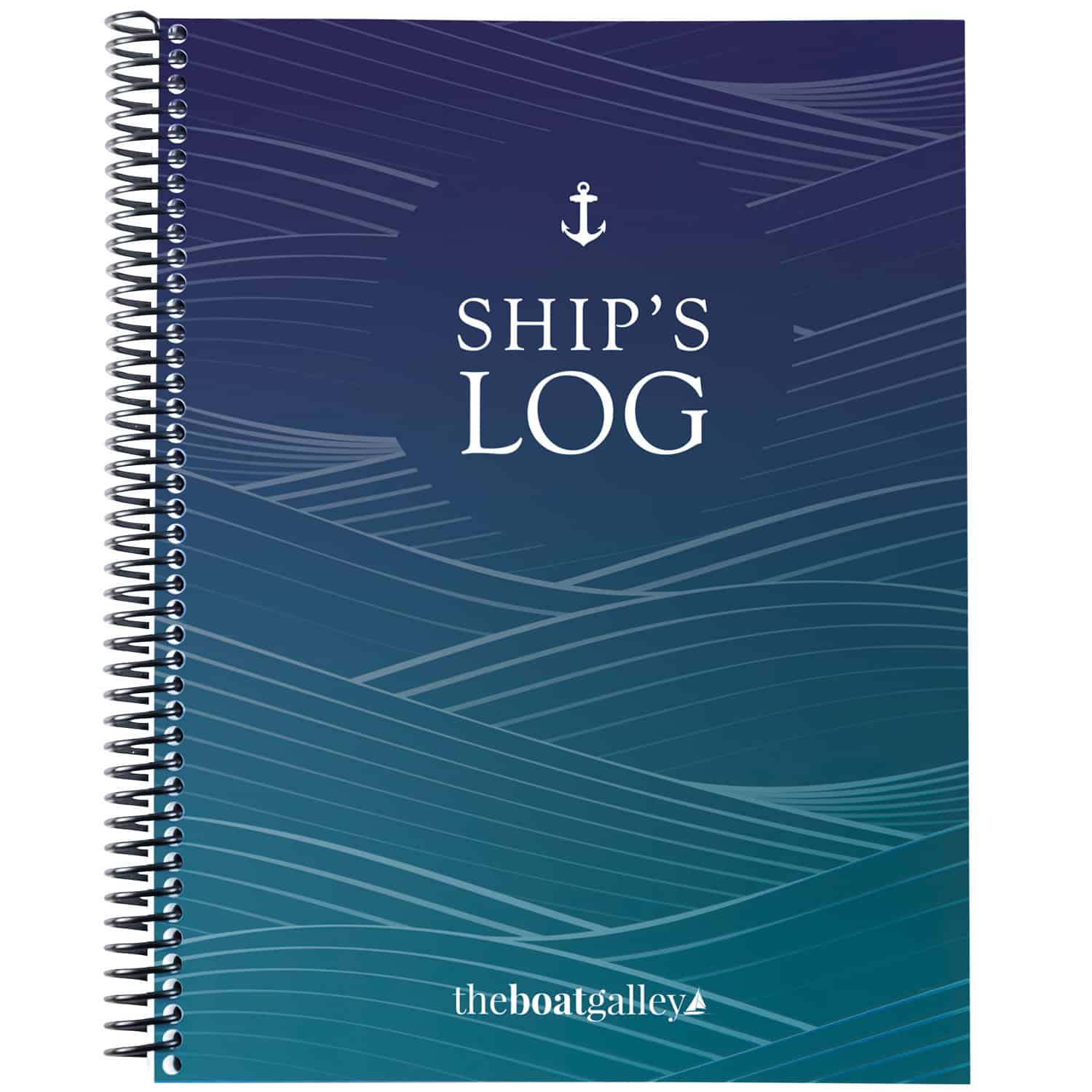
LaDonna Thomas says
Carolyn,
I would add that it is also very wise to snorkel the mooring to be sure it is in good shape and looks substantial at the bottom and not just a line tied up to an old engine block or several concrete blocks—–believe it or not this does happen sometimes down the island chain. A boat pays 30$ for a night and when it breaks loose no one is responsible for the mooring line! Even in the BVI some are not well maintained, but we have always found the ones on St John to be impeccably maintained.
Christine Dumaine Springfield says
Limiting the length of the lines to the pennant also makes sure that the boats don’t “bump butts” when the winds and tides have all of us headed weird directions. There is also a recommended storm configuration for tying off. There is an example up on the wall at the marina between the desk and package closet. You might want to add a picture of that too.
Great post!!!
Bill Aldy says
Hey Christine 🙂
Rock Spencer says
My version, for a catamaran. My best try at preventing chafe and twisting.
Samm Souvigny says
EXACTLY what we did
Jan Bogart says
Locals here tie up stern to ( motorboats) drives us crazy.
Samm Souvigny says
^^^ yes i was going to say. .. we use all metal to prevent chafing… we’ve had a boat run away on us due to not properly securing metal on metal
Cory Nickerson says
I was taught what I consider and even better way. When catching the ball I do just like you stated. However once secure, one line at a time I change the tie. I pass the eye splice of the line through the pennant, then the tag end throughthe eye and back to the cleat. Then the eye clinches to the pennant leaving to room for chafe at all on that side of things. And just because I’m a nervous Nelly, I have a soft shackle and pennant attached as well.
Brad says
I agree Totally with this system up here in Victoria BC Canada we have very nasty storms and quite exposed mooring fields. Many boats have hit the beach and of all the boats I have secured with putting the bite [loop] through the eye and then the ends back to the cleats have never failed…. one boat had 2 lines through the eye… All 4 lines broke under pressure @ the cleats but the mooring EYE with this lines did not suffer anything and was easy to remove the ropes. NOW on my boat I have the same system and have a “positive” length of chain hanging loose but attached to Shackles and to the mast through the bow roller just in case the two mooring lines fail.
Jeffrey Gegner says
I used to keep my boat on a mooring. 2 independent lines is a must. If one gives, you are still attached!
Diane Elizabeth Larson says
Thanks
LisaMarie Gauci Takacs says
Kent Takacs interesting article and comments
Mark & Cindy - s/v Cream Puff says
We use an 8000 lb rated carabiner to prevent any possibility of chafe. In addition we run a secondary safety through the eye.
Mark & Cindy
s/v Cream Puff
Nick says
Some mooring fields don’t want you to add your own lines and instead want their
pendant only on a cleat.
Ft myers has that ruling and we found out the hard way to shorten that pendant line
which very long compared to most others and in Ft Myers the wind and current
work against and will allow the pendant to wrap around the keel when the current and wind fight each other.
Most mooring fields have very short pendants and 2 lines work really well and always wear good gloves when grabbing that pendant line to prevet getting your hands cut up.
Nick
Rebecca Tommaseo Ponzetta says
Luigi
Laura Armstrong says
All moorings are definitely not created equal. I’ve been around moorings all my life in California and never seen the type in this article.
The Boat Galley says
What are the ones there like? All that I’ve run into in Mexico, east coast of the US and in the BVI have been pretty similar to this — not necessarily identical, but not far different.
Rick Osborne says
Rick Osborne says
You motor up to the Pole (Wand) and pull it in – grabbing the forward Loop & attach to Bow Cleat.
Then you pull the line attached to the Stern Loop – walking along the side deck toward the boat’s stern – and when you get to that Loop – you attach to Stern Cleat.
In some places – like the Isthmus – boats lay stern-to the mooring buoy – with the boat’s bow pointed to shore.
Carl Stevenson says
That’s at Catalina. I’ve never seen the fire and aft mooring anywhere else.
The Boat Galley says
Thanks! Never seen one like that, so it’s great in case I ever should . . .
Laura Armstrong says
Thanks, Rick! I lived on Catalina for 17 years. The Boat Galley, now you can understand why I was so perplexed by your post… ha ha!
Carolyn Shearlock says
And I would have been perplexed had I seen one like that!
Nancy Goff Duell says
Thanks.
Karla Steele says
Kalib Steele
Cindy Crowson says
Great info! Thanks!
Cheryl Geeting says
Thanks for the great tip! We’ve yet to learn how to do all of this, but will definitely remember this when the time comes.
Claudia Smyth Gilpin says
Great info. Thanks for sharing!
Bonnie says
We go one step further–some pennants are extra long for trawlers with high freeboard. Too long of a pennant can leave you with a mooring ball banging against the hull at current/wind shift (Beaufort, SC comes to mind)–sometimes resulting in “running over the ball” in our cat. In these cases, we skip the pennant and go straight to the eye on the mooring if possible.
Christopher Wick says
Thanks, great info. Will use it later.
Matthew D. Stone says
Cruising 2 years, we never picked up a mooring ball unless it was absolutely the only choice. Too many other boats too close, you don’t know what’s down there so no amount of clever tie on and anti chafing is going to protect u from that…carry a big anchor, lots of chain and a bigger faster dinghy so u can be away from crowded spots…when things get snotty and u decide u want to leave picking your way, in the dark invariably, through a crowded mooring field will add to your headaches…just my 2 cents!
Carolyn Shearlock says
In some places, mooring balls are really the only choice, unfortunately. I’d prefer to be on my own anchor!
William Holderby says
Excellent info…. Will make this standard operating procedure moving forward…..
LisaMarie Gauci Takacs says
Thanks!
Thomas Keenan says
One quick question: that large line with a thimble– what did you use to make that up? Love this idea!!
The Boat Galley says
That is the pennant on the mooring ball. It’s not ours. Our lines pass through that thimble.
Michael Carstensen says
The eye in the picture is made up using a nylon thimble. Nylon thimbles properly spliced are strong and serve to avoid chafing and damage to fiber glass better than galvanized steel. The nylon thimbles come in a variety of sizes and are very cheap to purchase through the internet.
Steve Payment says
We just launched over near Coco Plum last night to cruise the middle keys for a week. We will be in Boot Key later today. Let us know if you have time to connect today or tomorrow before we head further south. – Steve & Brandy, The Sailing Rode
The Boat Galley says
I sent you an email 🙂
JD Boyle says
Thanks for sharing!
Ray Majeau says
Nice tip thankyou
Karen Schroeder says
We have always done it this way…..works best for a catamaran.
Remy Mann says
Would be interested in techniques to get the line through the eye. Many boats don’t have a low enough vantage point to grab and loop- how goes everyone do it?
The Boat Galley says
It helps if the mooring ball has a long pennant, but basically the way we do it is for Dave (stronger, longer arms) to be on the bow with the boat hook. I’m at the helm (it’s what I’m best at). I sloooowly motor up to the mooring ball, with Dave using our headset to talk me right up to it. He has one end of the dock line already cleated on the boat, with the free end passed over the gunwale and looped back onto the deck with the end easily “grabbable.” He uses the boat hook to pull the pennant up (I am at the wheel keeping the boat in position — using a little reverse first to stop the boat’s motion, then perhaps just a touch of forward if it’s windy), grabs it in one hand, quickly sets the boat hook down and grabs the end of the line, passes it through the eye and cleats it. It doesn’t matter how long the line is at this point. Then he will pull on the first line to get the eye in reach again and put the second line through. If it’s windy, I may have to use a little forward so he can get to the eye in the pennant again. Once both lines are through and cleated, I leave the engine running but in neutral and go forward to help adjust them, put on chafe guard, etc. When it’s particularly windy, we only adjust one side at a time so both are never uncleated at the same time.
Sandra says
This is our method too but I’m the one with the boat hook. Sometimes easy, sometimes less so. But we’re switching tactics. We watched a couple on a big Selene with high bow. She used a grapple hook on the end of a length of rope to catch the pennant. It worked a charm. Will be trying this soon.
Remy Mann says
The Boat Galley thanks!
Sharon Scott Dow says
I wish they made the pennant eyes a little bigger in the BVI. It is sometimes hard to get two lines through them. A tight eye also makes it harder to release sometimes. Thanks for this info.
Katie Strader says
I have been boating for over 15 years and this is the first time I’ve heard this technique. I will certainly give it a go next time I’m out and use one of the club moorings. Thank you for all the great information you disseminate. Each of us owes you a hearty Thanks!
Alex Miller says
We are in process of replacing our mooring lines, after another broken line where they chafe each other. This is for our attachment to our permanent ball, so we connect two lines to the ball, with eyes in the ends coming straight to our cleats (Hunter, so our bow cleats are set back a couple of feet from the front of the bow. ) Our strategy this time to avoid the too- frequent replacement we have had so far:
1) shorten the lines to reduce wrapping around the ball during low wind. (And our mooring field has been made tighter this year.)
2) lash the two lines together for the first few feet, and attach floats. (Not sure what kind.)
3) have one line longer than the other (unnecessary with our cleats further back? Boat may just angle and take up slack?)
4) check on boat more often to find tangled lines.
5) keep our plastic tubing on the lines at the boat end to prevent lines from scrubbing the paint on the front. (Still working on the best way to keep them from sliding down. Used a stopper knot before, but want a better solution this time.)
Our issue every time so far has been the two lines chafing each other or wrapped around the bottom of the ball. But assuming these changes address that, our next weak link will be where the two lines attach to the shackle/swivel at the ball. Previously, we attached with bowline knots, it was always in a rush to get the lines hooked up. Three better (?) options we have considered:
1) anchor hitch knot.
2) rope to chain eye splice (I’m practicing my splices, and going to make the eyes for the boat ends.)
3) eye splice with thimble.
We have time to order something, so I think option 3 is what we want. There are many thimble types out there. I can’t figure out what kind we need for this application, or where to get them. 5000 lb, 27′ boat.
Suggestions?
Keith Davie says
And of course most of New England is different too. Up here we have a pennant with a simple loop spliced into the end. You pick it up and loop it directly over the bow cleat.
Ellen Jacobson says
That’s what they’re like in New Zealand too
BoBo Bailey says
Should you put some kind of chafing protection on the lines?
Keith Davie says
Properly rigged none is needed, as the two lines don’t work in the end of the pennant.
The Boat Galley says
You might want some on the boat end — depends how it attaches to your boat and whether there is a bobstay that the bridle could rub on. With our catamaran, none is needed.
Sherry Matas says
On a cat? Enjoy sleeping with the ball banging the hulls.
Nope. Nope. Nope.
The Boat Galley says
There’s enough wind and current here that we’ve had it bang.
Sherry Matas says
Our set up, we never bang…. or do donuts. Better set up for cats.
Sailing Florida Charters and Sailing School, Inc. says
thank you…
Ray Thackeray says
Unless there is good wind or current I will never again tie up to a steel ball. Banging against the hull and scraping off bootstripe and gelcoat is simply not worth it.
Thom says
I did an RYA course this year, and the technique they recommended was exactly as you described, for exactly the reasons you mention. We are in the process of getting a bridle for our anchor and I was thinking that, for mooring, it would be good to be able to swap the chain hook for a substantial shackle. Then we can just shackle on to the mooring eye hook for a metal-to-metal connection. The downside would be that you’re no longer able to get off by just slipping the lines. Any thoughts about whether that would be an improvement?
Carolyn Shearlock says
My concern would be how long it would take to get the shackle off in an emergency.
Anonymous says
I thought they wanted you to pass the spliced eye through and loop the free end back through the eye and then tie off on your cleat? The photos show two lines that would rub back and forth and chafe as the boat turns.
The Boat Galley says
The loop technique that you mentioned is used for hurricanes. With this method, the lines do not move as the boat moves — each line is led back to the same cleat it came from, so the length does not change as the boat moves.
Jen says
How about a mooring ball that just has a length of chain?
Carolyn Shearlock says
Ask whoever built the mooring how they intended for boats to attach. My guess would be to use mooring lines and tie to the chain with a rolling hitch and then take one to cleats on each side of the bow.
Serena says
Thanks for this post, Carolyn! We are arriving BKH next week for an extended stay and this will be our first mooring tie up so we appreciate your detailed “how to”. You are my “go to” for all things sailing 🙂 Looking forward to an opportunity to meet you while we are there. All best!
Carolyn Shearlock says
Can’t wait to meet in real life!
Jeff says
Under the part “how to tie to mooring ball” you show the orange buoy with the 3 ft of rope and the nice eye to pass both lines of the mooring rope thru. Where can I find the orange buoy with the nice eye?
Carolyn Shearlock says
Marathon City Marina, also known as Boot Key Harbor! It’s basically a buoy with 3-strand line through it and then an eyesplice around a thimble. I don’t think it comes pre-assembled — you can find 3-strand, buoys and thimbles at almost any chandlery and build your own. Building a mooring takes a fair amount of engineering to ensure that it will hold a boat in a storm, and there are numerous resources online with information on how to do so. Make sure that your insurance company will cover your boat on a DIY mooring.